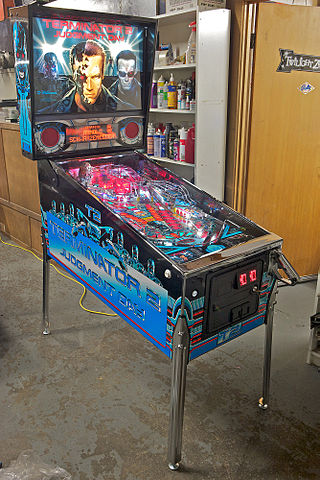
Pinball games are a family of games in which a ball is propelled into a specially designed table where it bounces off various obstacles, scoring points either en route or when it comes to rest. Historically the board was studded with nails called 'pins' and had hollows or pockets which scored points if the ball came to rest in them. Today, pinball is most commonly an arcade game in which the ball is fired into a specially designed cabinet known as a pinball machine, hitting various lights, bumpers, ramps, and other targets depending on its design.

An action figure is a poseable character model figure made most commonly of plastic, and often based upon characters from a film, comic book, military, video game or television program; fictional or historical. These figures are usually marketed toward boys and adult collectors. The term was coined by Hasbro in 1964 to market G.I. Joe to boys.
Toy guns are toys which imitate real guns, but are designed for recreational sport or casual play by children. From hand-carved wooden replicas to factory-produced pop guns and cap guns, toy guns come in all sizes, prices and materials such as wood, metal, plastic or any combination thereof. Many newer toy guns are brightly colored and oddly shaped to prevent them from being mistaken for real firearms.
Tiger Electronics Ltd. is an American toy manufacturer best known for its handheld electronic games, the Furby, the Talkboy, Giga Pets, the 2-XL robot, and audio games such as Brain Warp and the Brain Shift. When it was an independent company, Tiger Electronics Inc., its headquarters were in Vernon Hills, Illinois. It has been a subsidiary of Hasbro since 1998.
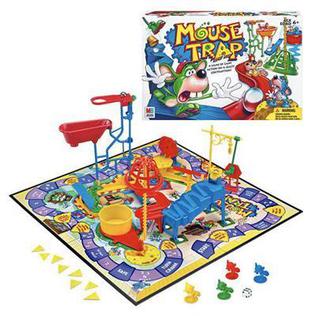
Mouse Trap is a board game first published by Ideal in 1963 for two to four players. It is one of the first mass-produced three-dimensional board games. Players at first cooperate to build a working mouse trap in the style of a Rube Goldberg machine. Then, players turn against each other to trap opponents' mouse-shaped game pieces.
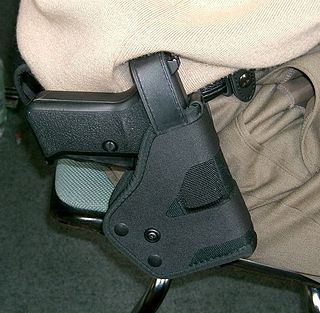
A handgun holster is a device used to hold or restrict the undesired movement of a handgun, most commonly in a location where it can be easily withdrawn for immediate use. Holsters are often attached to a belt or waistband, but they may be attached to other locations of the body. Holsters vary in the degree to which they secure or protect the firearm. Some holsters for law enforcement officers have a strap over the top of the holster to make the handgun less likely to fall out of the holster or harder for another person to grab the gun. Some holsters have a flap over the top to protect the gun from the elements.

B-Daman is a marble shooting toy franchise produced in Japan by Takara. It was originally based on the Bomberman series, but later expanded into other franchises and its own original designs.

Bop It, stylized as bop it! since 2008, is a line of audio game toys. By following a series of commands issued through voice recordings produced by a speaker by the toy, which has multiple inputs including pressable buttons, pull handles, twisting cranks, spinnable wheels, flickable switches, the player progresses and the pace of the game increases.

A crupper is a piece of tack used on horses and other equids to keep a saddle, harness or other equipment from sliding forward.
Littlest Pet Shop is a toy franchise and cartoon series owned by Hasbro and currently under license with Basic Fun!. The original toy series was produced by Kenner in the early 1990s. An animated television series was made in 1995 by Sunbow Productions and Jean Chalopin Creativite et Developpement, based on the franchise.

Perfection is a game originally produced by the Pennsylvania company Reed Toys and then by the Milton Bradley company. The object is to put all the pieces into matching holes on the board before the time limit runs out. When time runs out, the board springs up, causing many, if not all, of the pieces to fly out. In the most common version, there are 25 pieces to be placed into a 5×5 grid within 60 seconds.

A pack saddle is any device designed to be secured on the back of a horse, mule, or other working animal so it can carry heavy loads such as luggage, firewood, small cannons, or other things too heavy to be carried by humans.

Mall Madness is a shopping themed board game released by Milton Bradley in 1988.

Crocodile Dentist is a game made for young children, first published by Milton Bradley in 1990. A smaller travel version of the game was released in 1993 and is currently being produced by Winning Moves. The game was conceived by Robert B. Fuhrer, who later created Gator Golf, and many other toys and games.
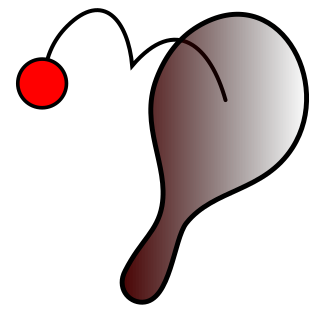
Paddle ball is a one-person game played with a paddle and an attached ball. Using the flat paddle with the small rubber ball attached at the center via an elastic string, the player tries to hit the ball with the paddle in succession as many times as possible.

A Nerf Blaster is a toy gun made by Hasbro that fires foam darts, arrows, discs, or foam balls. “Nerf blaster” or more commonly “Nerf gun” are often used to describe the toy. Nerf blasters are manufactured in multiple forms; the first Nerf blasters emerged in the late 1980s with the release of the Nerf Blast-a-Ball (1989) and the Sharpshooter (1992). Today, Hasbro has produced over twenty unique lines of Nerf-brand blasters, with each line centered on a particular theme or type of ammunition. Hasbro has also produced Nerf blasters based on specific franchises, including Marvel Comics, Star Wars, G.I. Joe, Fortnite, Transformers, Overwatch, Halo Infinite, Roblox and Minecraft. Nerf blasters are available in several international marketplaces, although some blasters have their names changed or are not sold in certain countries due to laws surrounding toy safety franchises.
The Man from U.N.C.L.E. gun often referred to as the U.N.C.L.E. Special is a fictional firearm depicted on the popular TV show The Man from U.N.C.L.E. which ran from September 1964 until it was canceled mid-season in 1968. Onscreen it was semi-automatic pistol that could be converted to a carbine-sniper rifle that could fire full automatic.
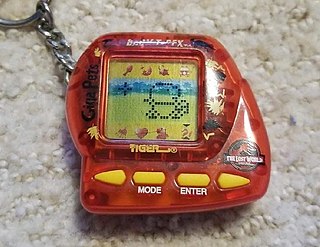
Giga Pets are digital pet toys that were first released by Tiger Electronics in the United States in 1997 in the midst of a virtual-pet toy fad. Available in a variety of different characters, each Giga Pet is a palm-sized unit with an LCD screen and attached key ring. To ensure a happy, healthy pet, its owner has to take care of it similar to how one might care for a real animal, including feeding, cleaning, and playing with their Giga Pet.

Monkgomery is a children's puppet. It takes the form of a talking monkey wearing a necktie, released by Hasbro in 1986. The toy is 17" in height and sits at approximately 14" tall. The toy has two Velcro strips on his hands allowing him to be hung from objects. The toy can also function as a cuddle buddy at night and a day time play toy. Additional speech modules provided 200 new words.
Toys-to-life is a video game feature using physical figurines or action figures to interact within the game. These toys use a near field communication (NFC), radio frequency identification (RFID), or image recognition data protocol to determine the individual figurine's proximity, and save a player's progress data to a storage medium located within that piece. It was one of the most lucrative branches of the video game industry especially during the late 1990s and 2010s, with the Skylanders franchise alone selling more than $3 billion worth over the course of four years.


















